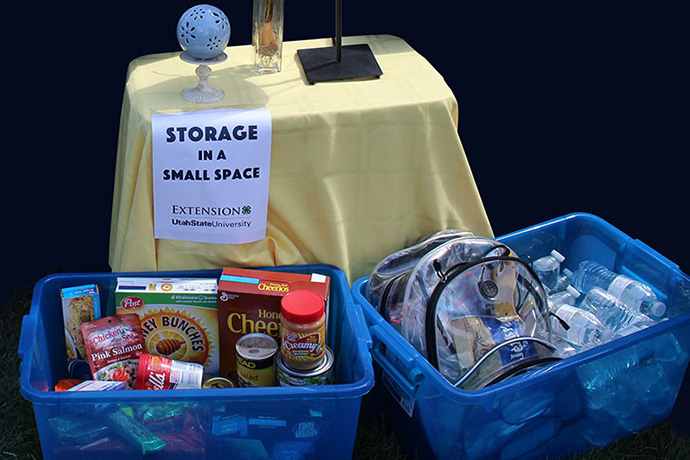Food Storage Possible in a Small Space
 September is National Preparedness Month, and for many people that means stocking up at the case lot sale, storing water and updating 72-hour kits. However, not everyone has the luxury of ample storage space. For those who live in a small house, apartment or dorm, finding a place to store extra food and emergency preparedness items can be a challenge.
September is National Preparedness Month, and for many people that means stocking up at the case lot sale, storing water and updating 72-hour kits. However, not everyone has the luxury of ample storage space. For those who live in a small house, apartment or dorm, finding a place to store extra food and emergency preparedness items can be a challenge.
Carolyn Washburn, Utah State University Extension associate professor, said it might require a little creativity to find storage space, but it can usually be done.
“Closets are great places to start since there is often unused space,” she said. “Food can be stored in the very top back shelves that you can’t use or on the floor in the back of the closet. Also consider the back of cupboards where access is difficult. For instance if you have number 10 cans, you can store them in the back of the cupboard and leave them, then place the foods you use regularly in front of the cans.”
In addition, the space under beds can be used for storing food and water, she said. Short-term storing of water in the garage is an option, but be aware of temperatures. Heat will not hurt or crack the plastic but the cold will.
“You can also get creative by filling two 5-gallon buckets or totes with food storage items and making a TV stand with a 5 foot, 2X12 piece of wood across the buckets and a tablecloth over the top,” she said. “Or make a coffee table by using three or four buckets or large totes with a cloth on top. A bedside table can be made using one bucket or tote. There are many furniture/storage possibilities if you look at your space and come up with a plan.”
Washburn said to store food in a cool, dark location when possible, and to keep it out of direct sunlight and moisture.
She said the top 10 foods to include in food storage are wheat; beans, legumes and lentils; white rice; pasta; dehydrated fruits and vegetables such as raisins, apples or tomatoes; nonfat powdered milk; sugar including honey or jam; oil and/or olive oil; salt, soda and baking powder; and nuts or peanut butter.
The top 10 foods for students to store include wheat; beans (chick peas, lentils that are easy to reconstitute); pasta; rice; canned meats including tuna, sardines and chicken; jam or honey; peanut butter; dehydrated fruits and vegetables such as raisins, apples or tomatoes; nonfat dehydrated milk; and beef jerky and cheese, which only have a 6-months shelf life, but provide good nutrition and are easy to grab.
Washburn said to be sure to have a 72-hour kit for each person and to include a solar cell phone and flashlight charger in case the power goes out.
“Besides the food and emergency kit, also be sure to store as much water as you have storage space for,” she said. “Recommendations are 1 gallon per person per day.”
When we become prepared for an emergency, we can reduce fear, anxiety and losses, Washburn said. Food storage preparedness can provide security and alleviate fear. Becoming better prepared strengthens families and communities.
Writer: Julene Reese, 435-797-0810, julene.reese@usu.edu
Contact: Carolyn Washburn, 435-634-2692, carolyn.washburn@usu.edu
What Next?
Get useful tips like this as soon as we release them. Sign up here.


 Utah 4-H & Youth
Utah 4-H & Youth